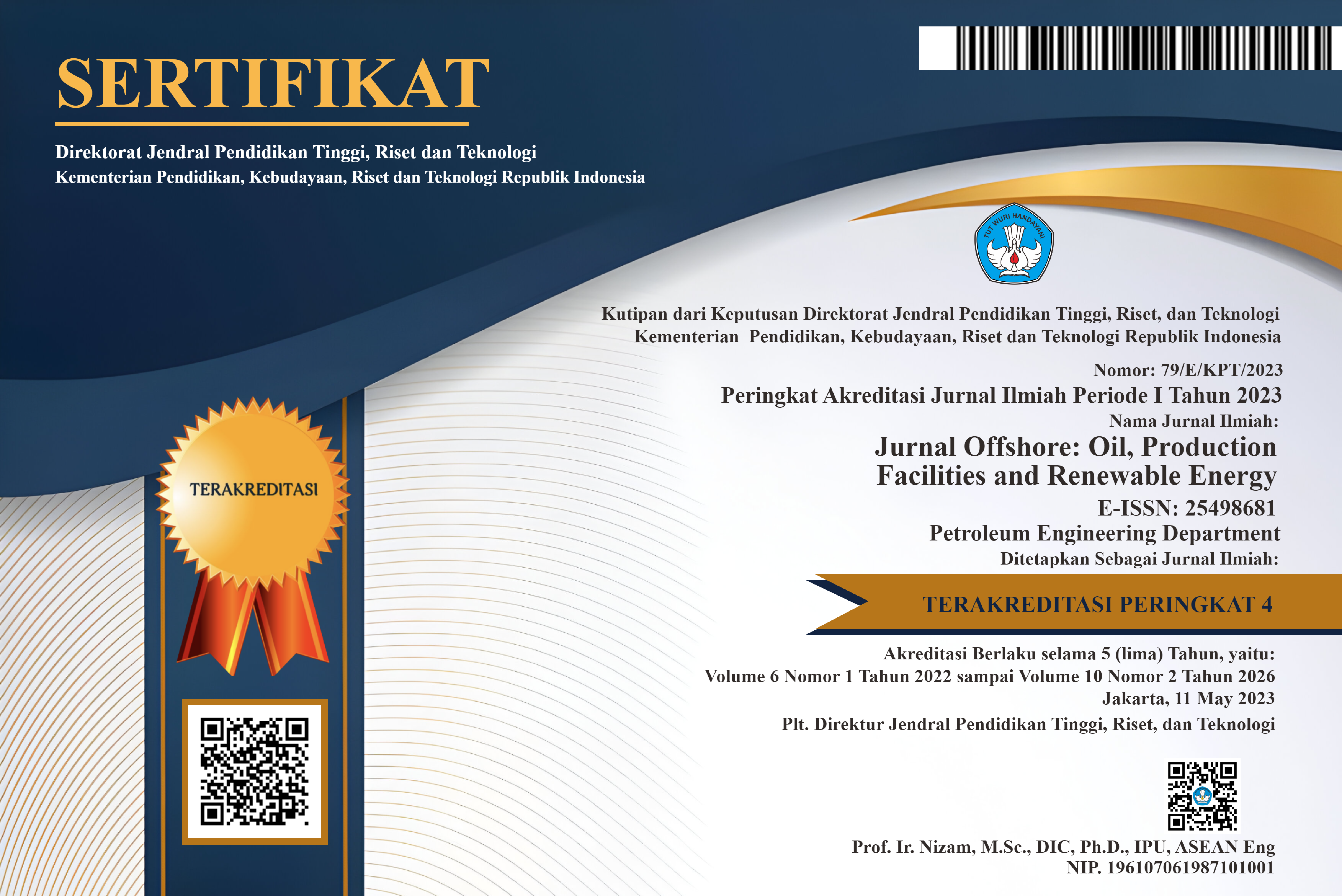Penentuan Current Recovery Factor dan Cadangan Sisa Sumur “Alpha” pada Lapisan “A” dan Lapisan “B”
DOI:
https://doi.org/10.30588/jo.v3i1.591Abstract
Abstrak
Sumur “ALPHA” merupakan sumur gas dari reservoir gas kering yang telah diproduksikan sejak Februari 1994. Sumur ini diproduksi secara commingle dari dua lapisan yaitu Lapisan “A” dan Lapisan “B” dari tiga sumur yaitu “ALPHA”, BETA”, dan “GAMMA”. Pada akhir dari Juni 2013, produksi telah menurun hingga laju sebesar 1,14 MMSCFD dari sumur “ALPHA” dan nol produksi dari sumur “BETA” dan “GAMMA”. Cadangan sisa ditentukan dengan menggunakan metode material balance dikarenakan sumur telah berproduksi untuk beberapa waktu. Untuk menentukan cadangan sisa, langkah pertama yang harus dilakukan adalah menghitung faktor Z dan faktor volume formasi gas (Bg). Setelah itu, hitung OGIP menggunakan metode material balance P/Z. Dengan software IPM, dengan masukkan semua data ke dalam sub-program MBAL. Jalankan software untuk matching nilai OGIP. Setelahnya, recovery factor, ultimate recovery, dan current recovery factor dapat ditentukan.Besarnya OGIP yang diperoleh dari metode material balance P/Z manual adalah 1407.29 BSCF, sedangkan OGIP dari metode material balance MBAL adalah 1341 BSCF. Recovery factor untuk Lapangan “X” adalah 80,2%. Current recovery factor lapangan “X” adalah 25,55%. Ultimate recovery factor untuk Lapangan “X” adalah 1128,64 BSCF. Maka cadangan sisa sampai 1 Juli 2013 adalah 769,094 BSCF. Berdasarkan hal ini, maka dapat disimpulkan bahwa sumur ini memiliki cadangan gas sisa yang masih dapat dioptimalkan untuk produksi.
Kata kunci: IPM Software, Remaining Reserve, Mature Field
Abstrack
The "ALPHA" well is a gas well from a dry gas reservoir that has been produced since February 1994. This well is produced commingently from two layers, namely "A" and "B" layers of three wells namely "ALPHA", BETA ", and" GAMMA ". At the end of June 2013, production had declined to a rate of 1.14 MMSCFD from the "ALPHA" well and zero production from the "BETA" and "GAMMA" wells. The remaining reserves are determined using the material balance method because the well has been producing for some time. To determine the remaining reserves, the first step that must be taken is to calculate the Z factor and the gas formation volume factor (Bg). After that, calculate the OGIP using the P / Z material balance method. With HDI software, enter all data into the MBAL sub-program. Run the software to match OGIP values. After that, recovery factor, ultimate recovery, and current recovery factor can be determined. The amount of OGIP obtained from the manual P / Z material balance method is 1407.29 BSCF, while the OGIP from the MBAL material balance method is 1341 BSCF. Recovery factor for "X" field is 80.2%. Current recovery factor of the "X" field is 25.55%. The ultimate recovery factor for "X" Field is 1128.64 BSCF. Then the remaining reserves until July 1, 2013 are 769,094 BSCF. Based on this, it can be concluded that this well has residual gas reserves that can still be optimized for production.
Keywords: IPM Software, Remaining Reserve, Mature Field
References
Ahmed, Tarek, “Reservoir Engineering Handbook Second Edition”, Gulf Professional Publishing, Houston, Texas, 2001. Chapter 2 (P.30, P.34, P.66-68).
Ahmed, Tarek, “Reservoir Engineering Handbook Fourth Edition”, Gulf Professional Publishing, Houston, Texas, 2010. Chapter 1 (P.10-15).
Ahmed, Tarek and McKinney, Paul D., “Advanced Reservoir Engineering”, Gulf Professional Publishing, Houston, Texas, 2005. Chapter 3 (P.201-205).
Amyx, J.W., D.M. Bass, Jr. and R.L. Whiting, “Petroleum Reservoir Engineering–Physical Properties”, McGraw-Hill Book Company, New York-Toronto-London, Chapter 2 (100-109),1960.
Hurst, William, “The Material Balance Equation”, Petroleum Reservoir Engineer, Houston, Texas, 1973.
Ojo, K.P, “Material Balance Revisited”, Society of Petroleum Engineers, Nigeria, 2006.
Kanu, Austin; dkk, “Advancement in Material Balance Analysis”, Society of Petroleum Engineers, Nigeria, 2014.
Shahamat M.S ; Clarkson, C.R, “Multiwell, Multiphase Flowing Material Balance”, University of Calgary, 2018.
Batycky, Rod ; Thiele, Marco, “Material Balance Applied to Dynamic Reservoir-Surveillance Patterns”, Streamsim Technologies, 2018.
Molokwu ; Onyekonwu, “Multi-Tank Material Balance Analysis in Heterogeneous Oil Reservoirs”, Society of Petroleum Engineers, 2017.
Downloads
Published
How to Cite
Issue
Section
License
Authors retain copyright and grant the Jurnal Offshore right of first publication with the work simultaneously licensed under a Creative Commons Attribution 4.0 International License that allows others to share (copy and redistribute the material in any medium or format) and adapt (remix, transform, and build upon the material) the work for any purpose, even commercially with an acknowledgement of the work's authorship and initial publication in Jurnal Offshore. Authors are able to enter into separate, additional contractual arrangements for the non-exclusive distribution of the journal's published version of the work (e.g., post it to an institutional repository or publish it in a book), with an acknowledgement of its initial publication in Jurnal Offshore. Authors are permitted and encouraged to post their work online (e.g., in institutional repositories or on their website) prior to and during the submission process, as it can lead to productive exchanges, as well as earlier and greater citation of published work (See The Effect of Open Access).















